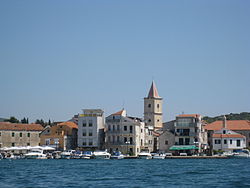Pirovac
| Pirovac | |
|---|---|
| Village | |
 |
|
| Location of Pirovac in Croatia | |
| Coordinates: 43°49′N 15°40′E / 43.817°N 15.667°E | |
| Country | Croatia |
| County | Šibenik-Knin |
| Area | |
| • Total | 25.5 km2 (9.8 sq mi) |
| Population (2001) | |
| • Total | 1,846 |
| Time zone | CET (UTC+1) |
| • Summer (DST) | CEST (UTC+2) |
| Website | http://www.pirovac.hr/eng/index.asp |
Pirovac is a coastal municipality and village in Croatia, formerly called Zlosela, 26 km from the city of Šibenik with a total of 1,846 inhabitants, 97% of which are Croats.
The first historical mention of Pirovac was in 1298, under the name "Zlosela". At that time, the village belonged to noblemen from Bribir — the Šubić family, and later it became the property of the Šibenik Diocese and noblemen from Šibenik.
The settlement itself was founded in the 15th century by refugees who fled from the Turks. Nevertheless, this area was inhabited many centuries earlier, as shown by remnants of Roman settlements found on the islet of Sveti Stjepan (St. Stephen). Many other historical monuments tell us about the gradual settlement and development of this place. The remnants of a Roman villa in Ivinj date back to the 1st AD. The site was proclaimed a cultural good in 2012 and awarded the status of a protected cultural monument.
The defence wall, erected around 1505 by Petar Draganić, has been partly preserved in the village. The 1506 parish church of St. George was restored in Baroque style in the 18th century. The graveyard chapel of the Draganić-Vrančić family features a Gothic sarcophagus with a relief made in 1447 by Andrija Budčić from Šibenik and Lorenzo Pincino from Venice, according to the sketches by Giorgio da Sebenico (George the Dalmatian). Roman artefacts have been found on the islet of Sveti Stjepan in front of the village; here also are the ruins of a Franciscan monastery (from 1511), which was abandoned in 1807.
The village of Kašić Banjevački in the municipality was home to a Partisan monument, which was destroyed during the Croatian War of Independence. In 2008, the village replaced the previous monument with a memorial chapel to the dead from both the Second World War and the War of Independence.
...
Wikipedia

